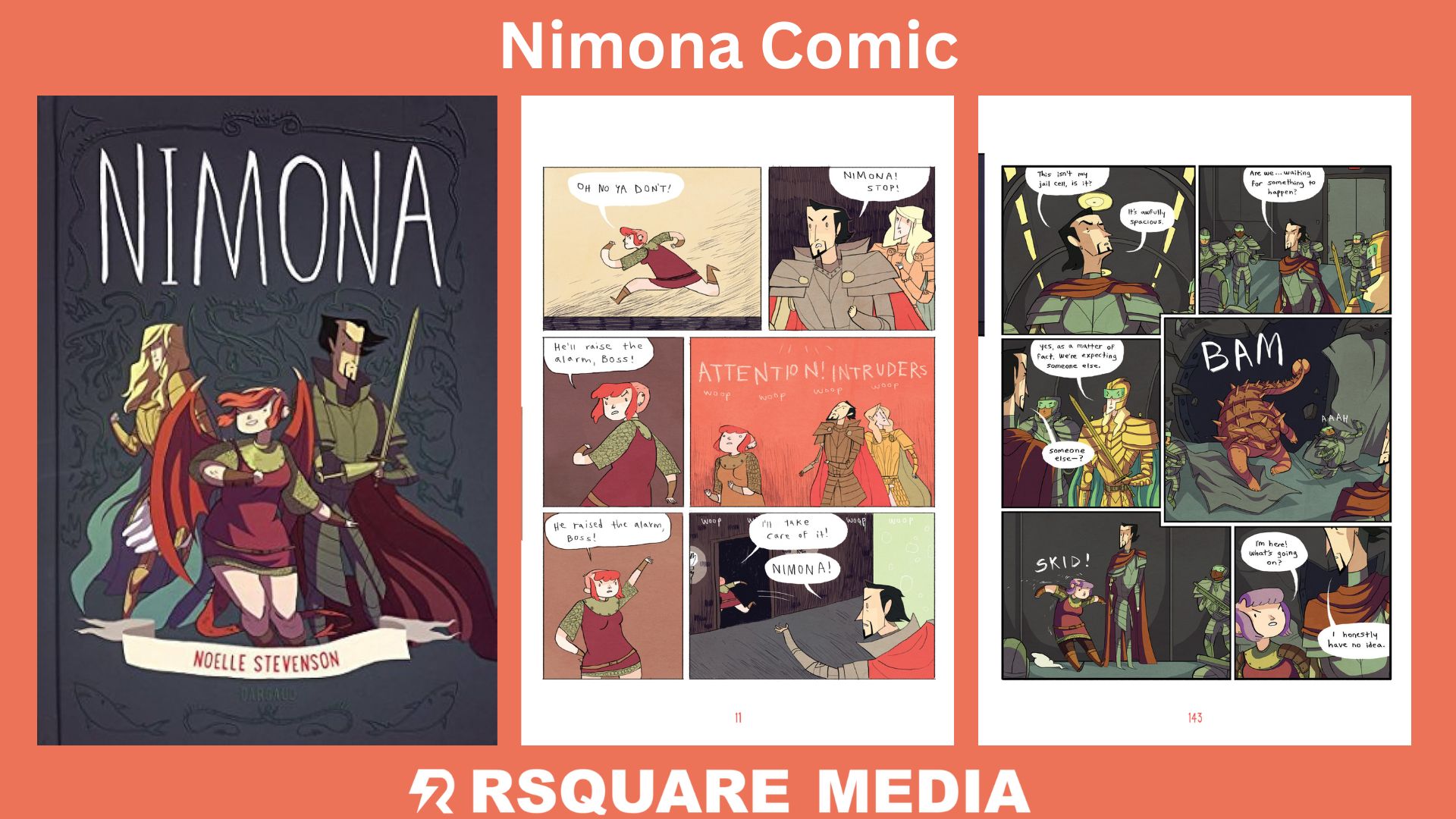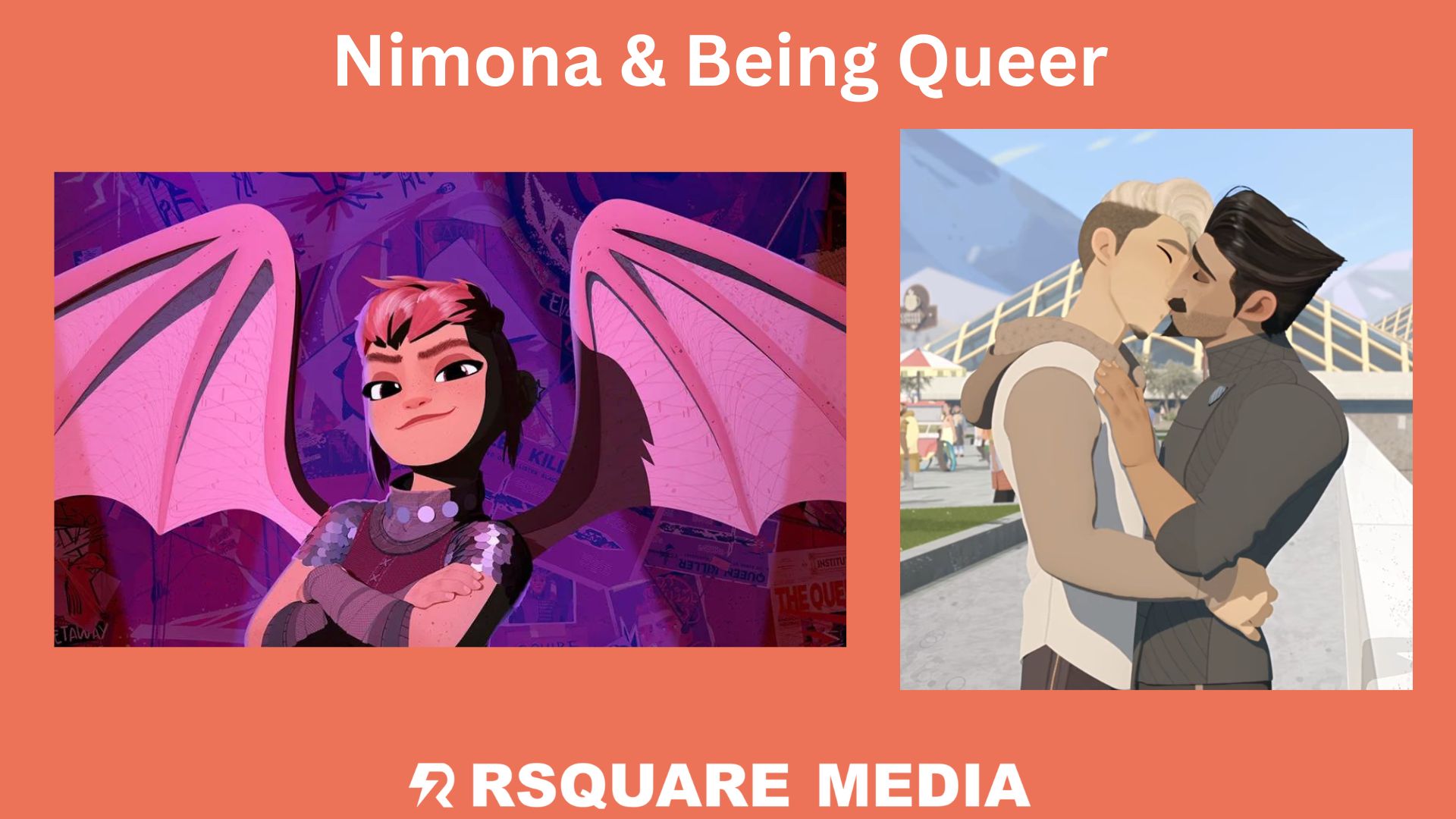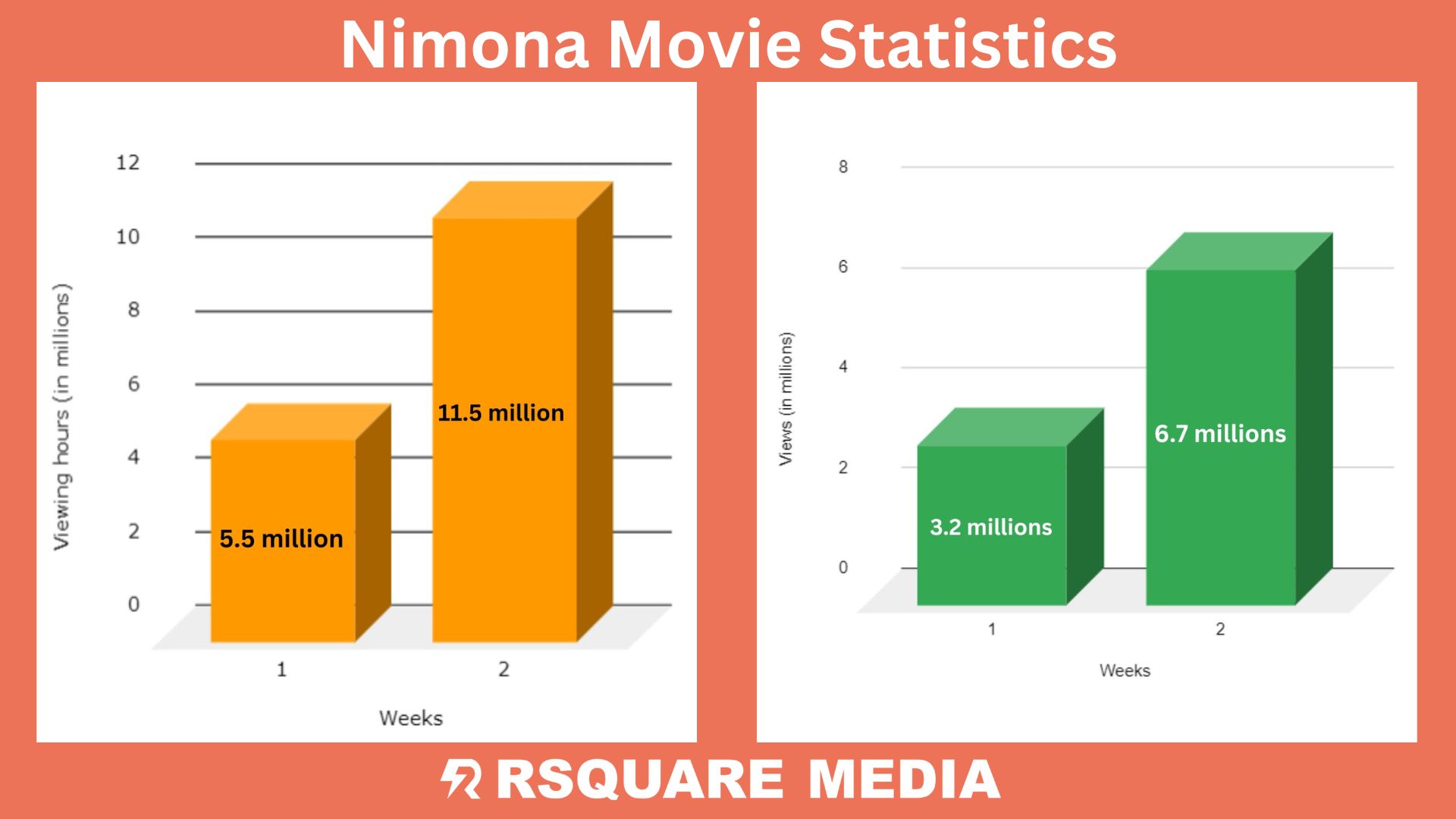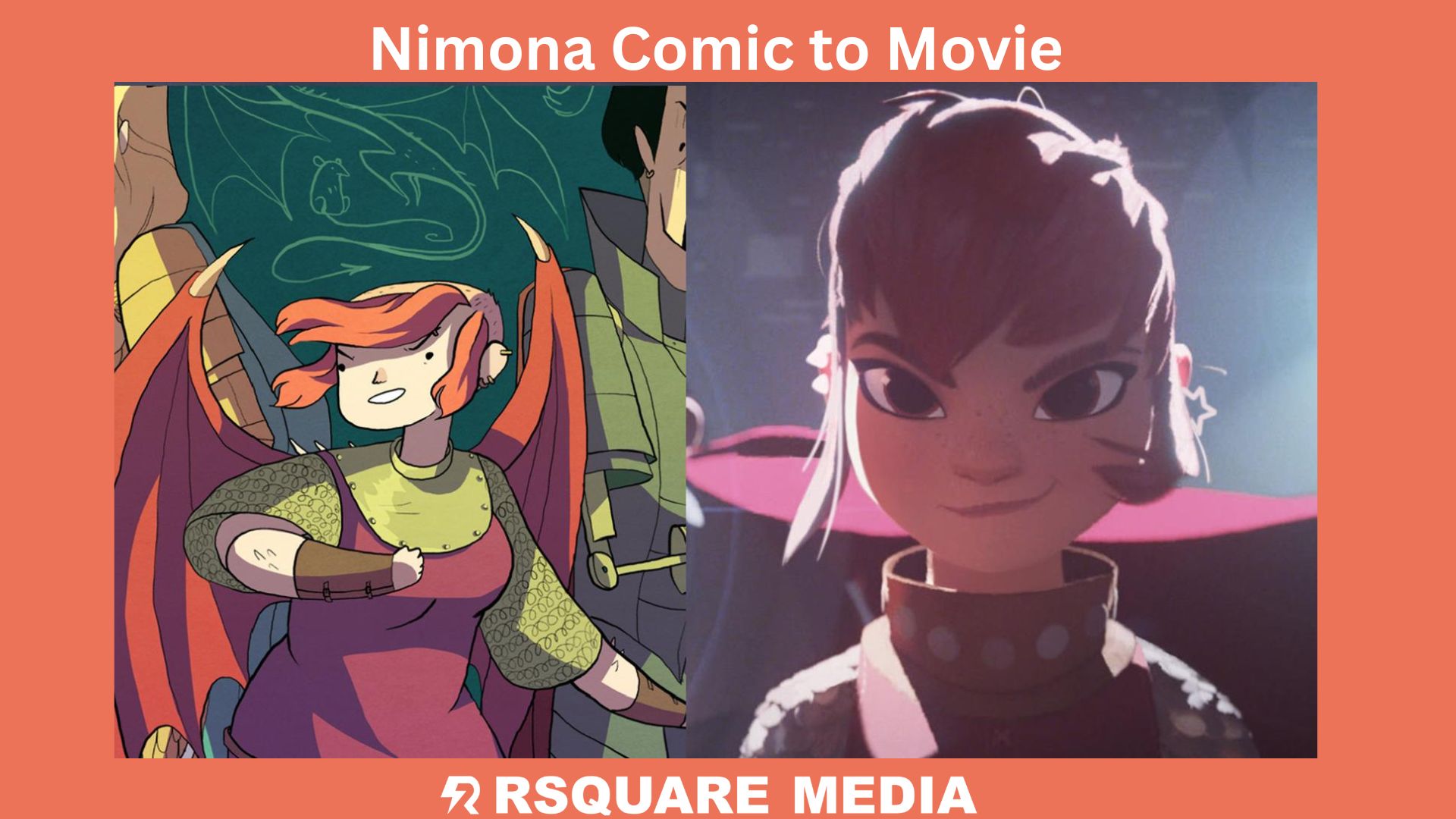AN INTRODUCTION TO NIMONA
The animated adaptation of the graphic novel Nimona was in the lineup to win Best Animated Picture at the Oscars, with stiff competition from Sony’s “Spider-Man: Across The Spider-Verse” and Studio Ghibli’s “The Boy and The Heron”. While “The Boy and The Heron” won the award, it is still amazing that a movie that went through production hell only to be discarded by Disney, and eventually remade by Annapurna Pictures made it into the running. From a graphic novel written over the course of 2012-2014 to an Oscar Nominated picture is a hell of a journey, lets learn a little about this film that beat so many odds.
WEBCOMIC TURNED GRAPHIC NOVEL

On December 6th 2011 ND Stevenson posted on his Tumblr account a design of a girl in a fantasy type of outfit with a shaved head and a pink mohawk and a man with dark hair and a receding hairline in armor, a cloak and a robotic right arm. The caption has her name as Nimona but the man is unnamed. Stevenson calls them “The Batman and Robin of slightly Medieval villains” and goes on to say that Nimona is the more evil of the two and that he will make a two page comic about them. From 2012 to 2014 he makes the comic, growing as both an artist and writer. In 2015 it is made into a graphic novel.
In the webcomic turned graphic novel the titular shapeshifter Nimona infiltrates the most evil man in the kingdom’s secret lair, Ballister Blackheart, a former knight of The Institute. He lost his arm in a jousting match against his arch nemesis Ambrosius Goldenloin, now the Institutes’ champion, they have been enemies for many years. Nimona and Blackheart unearth that the Institute is experimenting with a poisonous plant used for dark magic, they use Nimona’s shapeshifting powers to expose it, and nonfatally poison people with apples. Goldenloin meets with Blackheart in a tavern after being ordered to kill Nimona. He begs Blackheart to send her away for her own safety but Blackheart doesn’t believe him. Over the course of the story Goldenloin refuses to kill either Blackheart or Nimona.
Blackheart and Nimona meet a doctor named Meredith Blitzmeyer who made a device powered by “anomalous energy” that prevents Nimona from shapeshifting when nearby. They know they must keep it a secret from the Institute.
Nimona over the course of the story has given a few explanations for her powers, which are revealed to be false later on and Nimona was a shapeshifter found by a village, who turned her over to the Institute and experimented on her.
The graphic novel ends with Nimona being experimented on again, but when her blood is taken it transforms into a monster that rampages and slaughters the Institute, including The Director. Goldenloin and Blackheart team up to stop it and free Nimona, but when Nimona finds that Blackheart has shown Goldenloin the mysterious device, she feels betrayed and refuses to flee with him and Goldenloin. Blackheart battles the monster and kills it, apologizing to Nimona. The Institute explodes. Together the two knights flee and Blackheart is reinstated as a knight. They live life together, and Blackheart never sees Nimona again, but wonders if she is disguised somewhere.
The graphic novel is a much more violent and grim story than the PG animated movie, and has a few more subplots going on, though they do touch on the same themes.
NETFLIX MOVIE ADAPTATION

The Netflix adaptation of “Nimona” brings to life the beloved graphic novel created by ND Stevenson, weaving a captivating tale of adventure, friendship, and self-discovery. Originally slated for production by BlueSky Studios, known for their work on animated hits like the “Ice Age” franchise, “Nimona” faced a setback when Disney acquired BlueSky, subsequently shelving the project. However, fate smiled upon the adaptation when Netflix stepped in to rescue it, recognizing the potential of Stevenson’s imaginative world and compelling characters.
Taking the reins of animation production from BlueSky, Annapurna Pictures embraced the challenge of bringing “Nimona” to the screen. Known for their commitment to artistic excellence and storytelling innovation, Annapurna Pictures poured their creative energy into crafting a visually stunning and emotionally resonant adaptation that stays true to the spirit of the original graphic novel.
At its core, “Nimona” is a modern twist on the classic tale of knights and villains, set in a fantastical world where science and magic intertwine. The story follows Ballister Boldheart, a disgraced knight framed for the murder of Queen Valerin at a knighting ceremony, and Nimona, a spirited shape-shifter with a penchant for mischief. When Nimona seeks out Boldheart to offer her services as his sidekick, they embark on a quest to uncover the truth behind the queen’s death and clear Boldheart’s name.
Central to the story is the complex relationship between Boldheart and Ambrosius Goldenloin, boyfriends who were driven apart by the murder of the queen. Goldenloin, now a revered hero within the Institute For Elite Knights, struggles with conflicting loyalties and his feelings for Boldheart. Their dynamic adds depth and nuance to the narrative, exploring themes of betrayal, redemption, and the gray areas between heroism and villainy.
The finale of the movie takes place after Boldheart wavers in his trust of Nimona, and brings the Institute back to his lair. Nimona escapes and she relives her past, crying on a hillside, of 1000 yeas of isolation and trying to find her place among people. She then transforms into a giant shadowy creature and wrecks havoc on the city. The Institute throws everything at her and it doesn’t work. Boldheart tries to stop her to help her and she attempts to impale herself on the statue of Gloreth in her grief and feelings of betrayal. Boldheart yells at her to stop and apologizes for betraying her. Nimona returns to her human form and they embrace. The Director of the Institute still is adamant in killing Nimona and she sets a defense turret on Nimona and Boldheart, which would destroy half the city. Nimona turns into a brilliant red and pink phoenix and says she has to take care of something before zooming at the turret and destroying both it and herself.
Boldheart mourns her death, but the city celebrates Goldenloin, Boldheart and Nimona as heroes. Goldenloin and Boldheart are happily together. He started to clean his lair when there is a knock on his door. He opens the door to find nothing, but then a pink red glow comes from behind and we hear “hey Boss”, Boldheart turns around delighted to see his friend once again with a “HOLY SH–” and then credits roll, which is, in this writer’s opinion, the funniest way to end a PG movie.
NIMONA & BEING QUEER

Nimona has always been queer, it is baked into the text of the comic and movie. Both versions of Nimona feature a society that hates those outside the norm, and makes them “Others” that are to be feared. The Institute in both versions make Nimona and Ballister out to be the worst of the worst. This is something queer people across all of time know and have experienced in some way or another.
There is some raw storytelling in the comic, as Stevenson put his complicated relationship with gender and sexuality into a metaphor about a shapeshifter who has been tormented by a society that is propagandized against it. And the shapeshifter decides that they have had enough and rebels. I think it is beautiful to have the story like that. It is filled with queer grief and love. It is an incredibly personal story that many queer people, especially trans people, can relate to. It is a way for all queer people to scream about the injustices they have been dealt, to see it articulated into a moving piece of fiction.
In 2014, which was both the year when the comic ended and I had probably first learned about transgender people, there was a Tumblr post circulating about a young trans girl who had taken her own life due to unsupportive family and community. My first experience of queerness as I was navigating my own newfound identity was mourning a girl who was only a few years older than me. That is an experience I reflect on a lot, and I remember it making ripples across the internet as the queer community mourned her loss. I don’t know if Stevenson was posting the comic at the same time as this moment, but the themes certainly aligned, as Nimona was also more willing to stay to be killed in the exploding Institute than to continue in a world that had caused her so much pain. There is a line in the movie version of Nimona in which Boldheart and Nimona have a heart to heart. He asks her what it is like to transform and she says it just comes naturally to her. He then asks what if she tried to suppress it and she says it would kill her, not literally but a part of her would die and it would feel like she was dying.
If the comic is a trans person screaming their voice raw into what feels like an uncaring world, this is a gentle hand on the shoulder of that same person but older saying “hey things can get better”. And it is so full of love and hope for a better world. It is a masterful mode of storytelling. It is raw in a different way, raw in a soft way, the way a hug is. The movie wraps queer kids in their arms and kisses them on the forehead, telling them that things can work out. It’s a message that is needed now more than ever with all these anti-queer laws going into effect. And actually since this movie has come out in summer 2023 some of the laws have been repealed, or stripped of certain sections, and other states and countries have passed laws supporting queer, and the general population have been more supportive for queer people. There is hope for queer people, and we can be the change we want to see in the world. It is what all these shows since the 90s have slowly been pushing towards, casual queer representation and acceptance. A world where we don’t have to deal with institutions villainizing us. And it is possible, and this movie’s existence despite all odds stacked against it, has helped pave the way for that future.
PRAISE FOR NIMONA

What sets “Nimona” apart is its rich tapestry of characters, many of whom defy traditional gender and sexual norms. Nimona herself is a bold and unabashedly queer protagonist, challenging stereotypes and breaking boundaries with her fearless attitude and fluid identity. Through Nimona and other queer characters, the film celebrates diversity and inclusion, offering representation and visibility to underrepresented communities.
Despite its fantastical setting and larger-than-life characters, “Nimona” is grounded in universal themes of identity, acceptance, and the power of friendship. As Nimona and Boldheart navigate the twists and turns of their adventure, they confront their own insecurities and fears, learning to embrace their true selves and find strength in each other.
Visually, “Nimona” is a feast for the eyes, with breathtaking animation that brings Stevenson’s vibrant world to life. From the intricate details of the characters’ designs to the lush landscapes and dynamic action sequences, every frame is meticulously crafted to captivate and enchant audiences of all ages.

Less than two weeks after premiering on Netflix, the movie was the third most watched movie on the platform of the week, jumping up from ninth place the previous week. The hours watched increased from 5.5 million to 11.5 million, and the views doubled from 3.2 million to 6.7 million. So the movie was very well received, enough so to be in the running for Best Animated Picture Oscar.
As awards season approached, there was widespread anticipation and excitement surrounding “Nimona,” with many hopeful that it will be recognized for its outstanding achievements. Netflix even posted it on YouTube for free for a limited time, hoping more people would be able to watch it without the barrier of a Netflix subscription. The film’s blend of heartwarming storytelling, groundbreaking representation, and breathtaking animation made it a strong contender for Best Animated Picture. Fans eagerly waited to see if Nimona would win the nomination, though as stated at the start it had stiff competition with “Spider-Man: Across The Spider-Verse” and Studio Ghibli’s “The Boy and The Heron”. While “The Boy and The Heron” won the nomination and its a Ghibli movie so it definitely deserves it, it is sad to see “Nimona” lose, though it’s a miracle that it made it through the hellish development cycle to the Oscars.
In conclusion, “Nimona” is more than just a movie; it’s a celebration of imagination, creativity, and the power of storytelling to inspire and uplift. With its compelling characters, engaging plot, and visually stunning animation, it promises to leave a lasting impression on audiences around the world. Whether you’re a fan of fantasy adventures or simply appreciate a good story, “Nimona” is a must-watch film that delights, entertains, and leaves you wanting more.
If you’re an underdog like Nimona, contact RSquare Media to get a free consultation.

